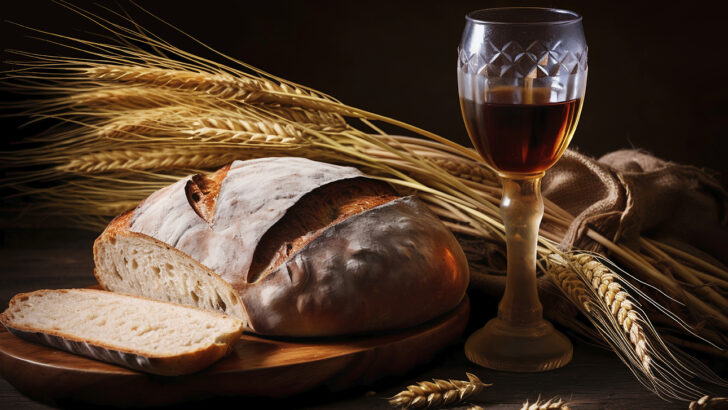At the Last Supper when Jesus instituted the Eucharist, He chose to use two elements, bread and wine. The images are now so deeply ingrained in our consciousness that we never stop to ask, why bread and wine? Among all the things Jesus might have chosen, why these two? What do they carry in themselves that make them particularly apt to give expression to the body and blood of Christ? What, more particularly, does each represent?
As they are used in the Eucharist, bread and wine symbolise very different aspects of our lives, of our world, and of Jesus’ life.
Bread. What is bread? What did it represent for Jesus at that first Eucharist? A loaf of bread is made up of many kernels of wheat which when ground up lose their separate identity and become a single loaf. In the Eucharist, the bread represents us, many individuals, now together as one body, the Body of Christ. But it also represents a particular aspect of our lives, namely, our lives insofar as we are joyous, healthy, in community with each other, and thriving as God’s children. The smell of fresh bread speaks of life. So does the bread at the Eucharist. It becomes the bread of the world’s achievements and holds up for God’s blessing all that is young, healthy, creative, and bursting with life.
Metaphorically
Metaphorically, the bread celebrates the Galilean period in Jesus’ life and in our own lives – the time of youth, of miracles, of walking on water, of raising people from the dead, of the joyous energy of life, of falling in love, and of the birth of new life.
The wine. What did it represent for Jesus and what does it represent in the Eucharist? Wine is made from crushed grapes and represents blood. And as the blood of Christ, it represents all that is broken, fragile, not whole, sick, suffering, and dying in the world. It is the wine of the world’s mortality and inadequacy, the blood of all is crushed as the world’s achievements take place.
Metaphorically, the wine commemorates the Jerusalem period of Jesus’ life and that period in our own lives – the time of misunderstanding, of being the victim, of mental anguish, of physical anguish, of being ostracised, of the loneliness of dying when others can’t help us.
Balanced
And the two together make for one balanced whole, life in all its aspects. In effect, when the presider at a Eucharist holds up the bread and wine, this what is being said: ‘Lord, what I hold up for you today is all that is in this world, both of joy and suffering – the bread of the world’s achievements and the blood of all that’s crushed as those achievements take place. I offer you everything that is healthy and thriving in our world – the joy at our tables, the joy of children, the hopeful dreams of the young, the satisfaction of achievement, and everything that’s creative and bursting with life, even as I offer you all that is weak, feeble, aged, crushed, sick, dying, and victimised. I offer to you all the pagan beauties, pleasures, and joys of this life, even as I stand with you under the cross, affirming that the one who is excluded from earthly pleasure is the cornerstone of the community. I offer you the strong, along with the weak and gentle of heart, asking you to bless both and stretch my heart so that it can, like you, hold and bless everything that is. I offer you both the wonders and the pains of this world, your world.’
Spirituality might take some lessons from this. Too often spiritualities are one-sided and need balance.
On the one hand, a spirituality can centre itself too one-sidedly on human thriving to the neglect of human inadequacy: suffering, sin, mortality, and of Jesus’ invitation to take up his cross. It celebrates only youth, health, prosperity, and goodness – and presents a Jesus who offers us a ‘Prosperity Gospel’ rather than a Whole Gospel.
Conversely, a spirituality can centre itself too one-sidedly on human inadequacy: sin, mortality, asceticism, and the renunciation of pleasure. It celebrates the old but not the young, the sick but not the healthy, the poor but not the prosperous, the dying but not the living, and the next world but not this one. This strips the Gospel of its wholeness and presents a Jesus who is an unhealthy ascetic and frowns on natural human happiness.
Voice
The bread and wine in the Eucharist give voice to all aspects of life. In the words of Pierre Teilhard de Chardin, the words of consecration at a Eucharist in essence read like this: “Over every living thing which is to spring up, to grow, to flower, to ripen during this day, I say again the words: ‘This is my body’. And over every death-force which waits in readiness to corrode, to wither, to cut down, I speak again your words which express the supreme mystery of faith: ‘This is my blood.’”


 Fr Ronald Rolheiser
Fr Ronald Rolheiser Bread and wine as symbols of hospitality.
Bread and wine as symbols of hospitality. 